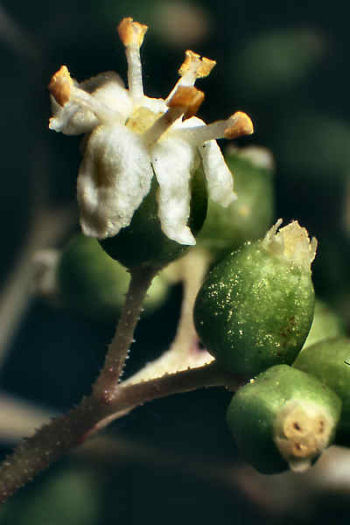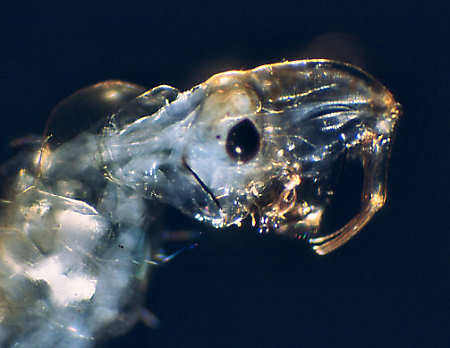Encapsulation

Right click to Download hi-res photo file.
File size:251kb Type:JPG

Right click to Download hi-res photo file.
File size:117kb Type:JPG





Observable Order
The Book of Nature is always open but how do we read its symbols? As we study its pages like an archeologist studying the strange glyphs of an ancient people we wonder at their meaning, so impossibly complex and yet so close. How can we find the general principles upon which life is structured? We have passed many important milestones along the way but we have not yet understood the meaning of the organization of life....more.
Mechanization and Centralization
This primary biological problem was stated nearly forty years ago by biologist and philosopher Ludwig von Bertalanffy (General Systems Theory, 1969):
"In biology, organisms are, by definition, organized things. But although we have an enormous amount of data on biological organization, from biochemistry to cytology to histology and anatomy, we do not have a theory of biological organization, i.e. a conceptual model which permits explanation of the empirical facts."In his efforts to describe biological organization he asserts two trends (among others) in living systems: progressive mechanization and progressive centralization...more. Although mechanized behavior of organisms should be a topic of great interest to all modern primates we will leave it for a later essay and instead hold in mind the idea of centralization.
Centralization as used by von Bertalanffy means centralization of control which implies the centralization of the nervous system concomitant with progressive individualization as an evolutionary trend. The trend toward centralization of the nervous system in more evolved animals appears certain yet its equivalence to progressive individualization is less clear. Some confusion arises from the meaning of the word "individual".
As von Bertalanffy points out, the "individuals" of many lower species such as flatworms can actually be divided- with a knife!, and they will regenerate into two or more complete "individuals". To add to the confusion, "individual" is often used to mean a self sufficient person distinct from the mass of society, although no humans actually live under such conditions. Nonetheless Bertalanffy's emphasis on centralization as a basic trend in animals seems to be on the right track, but what constitutes an individual depends on one's perspective.
Corpusculization and Autonomy
Another great biologist-philosopher who remains an active force over fifty years after his sudden death in New York City in 1955 is Pierre Teilhard de Chardin. Father Teilhard, a Jesuit priest, was forbidden to publish The Phenomenon of Man (1956) during his own lifetime. In that book he used a new word now in common use, "noosphere". He reiterated his ideas in Man's Place in Nature. In this little book Teilhard de Chardin, uses the concept of "corpusculization", an evolutionary trend descriptive of the formation of matter into ever larger and more complex wholes. Early on he gives a clear statement of this process:
"...the corpuscle, a unit truly and doubly 'natural' in the sense that while organically limited in its contours so far as its own existence is concerned it also, at certain higher levels of internal complexity, manifests strictly autonomous (his italics) phenomena."Here again we find the confluence of two ideas, the formation of wholes and their relative independence or autonomy. In his view this process has resulted in our present age in the formation of the noosphere, a collective, global entity, based on man's increasing psychism and socialization...more.
Autopoietic Machines
Francisco Varela who suffered an early death in 2001, developed the idea of successive wholes and autonomy even further by using the word "autopoiesis" which he defined as "self-producing".
"It follows that an autopoietic machine continuously generates and specifies its own organization through its operation as a system of production of its own components, and does this in a endless turnover of components under conditions of continuous perturbations and compensation of perturbations. Therefore, an autopoietic machine is a homeostatic (or rather a relations static) system that has its own organization (defining network of relations) as the fundamental invariant." (Principles of Biological Autonomy 1979)
Varela then develops ideas of autonomy, structure, organization,and individuality...more. His statements are often abstract because he is searching for the over-arching principles that link all biological entities regardless of mechanisms. His descriptions of structured relationships rather than causality develop an epistemology and philosophy of biological and social phenomena.
Encapsulated Entities
We come therefore to a jumping off place where we can compare our own observations to these ideas. I have quoted from only a few well known works of recent years. Rather than use the word "corpusculization" or "centralization" I am going to use the word "encapsulation" to describe the evolutionary trend because the commonly accepted meaning of this word can convey structural as well as organizational closure. I will use it in that dual (and for now ambiguous) sense. The general idea (with some additions) can be stated thus: All biological entities are organized according to the principles of encapsulation, and their structures are distributed according to the principles of symmetry and repetition (metamerism). Furthermore this organization bestows a relative autonomy. This form of organization can be easily seen in the morphology of both plants and animals.
Let's look at some specific examples of encapsulated structures in plants. The most highly encapsulated plant entities are the generative cells and their containers. The generative cells include gametes, spores, and pollen. Archegonia and antheridia are the containers that encapsulate the developing gametes, cells destined for sexual fusion. Sporangia are the containers that produce spores, cells which do not require fusion to develop into whole organisms. Ovules enclose megaspores, the precursor to the seed in seed producing plants. Finally, carpels enclose the developing ovules.
The culmination of this sequence of encapsulation is the flower itself which comprises most of the foregoing structures. Although it could rightly be said that the terrestrial environment requires a high degree of encapsulation for plant embryos to survive it should also be noted that increasing complexity is accompanied by encapsulation in all environments.
Repetition and Fusion
Just as cells are the encapsulation of molecular interactions, organs are the encapsulation of cellular interactions. A cluster of interacting organs is again encapsulated by a body segment (where segments are present through metamerism). The repetition of relatively independent segements is known as metamerism and is especially pronounced in many invertebrates and is considered to be the primitive condition. Many modern invertebrates and vertebrates further encapsulate groups of body segments by fusion of adjacent parts and this conceals the underlying details of structure while emphasizing higher level organization. Segmental architecture is apparent in many phyla of plants and animals, from worms to humans.
Segmental structure is clearly evident in vascular plants. The unit of repetition is marked externally by the stem node. Leaf and bud primordia formed by the apical meristem are distributed at regular, unequal intervals along the stem at each node and differentiate into vegetative or reproductive organs. The pattern of distribution of buds, leaves, and their derivatives is widely recognized and is known as spiral phyllotaxis, but its causes have not yet been discovered. In non vascular plants (mosses and liverworts) a similar rhythm occurs. The repetition and subsequent fusion and specialization of body parts is ubiquitous.
Polarization and Symmetry
The spatial arrangement of the parts of organisms begins at a very early stage of development, prior to the egg itself. Symmetry is sometimes considered to be a property of space, but it also remains unexplained. Its cause can be intuited by the observation of the form and behavior of living organisms. In matter it appears as various forms of polarization such as spin, charge, phase etc, all forms of paired opposition. Thus symmetry is a derived character, produced by reflection or polarization. Paired opposites, such as birth and death, have been recognized from earliest times and symbolized in ancient iconography...more.
Since space is an n-dimensional manifold, the three dimensional symmetries of our sensory world represent an accurate but low resolution image of the whole...more. A cascade of polarizations and the subsequent encapsulation of their material condensations are realized in our world as molecular configurations which inevitably are incorporated into organic entities. The point is that atoms and molecules are not a beginning but are rather late in a series of encapsulations which begin in an n-dimensional space. However, the properties of that space remain encapsulated in our own. The exact species of molecules and their electrical configurations are expressed in the form and behavior of the organism.
Encapsulation vs Evolution
Encapsulation is a specific form of Chinese boxes. It can be understood as a summative sequence where each box contains a smaller box. The biggest box has many boxes inside of it, each one of which represents a different level of organization. Unlike simple Chinese boxes, biological life form boxes can contain millions of smaller boxes and each small box can contain millions of even smaller boxes in turn. But encapsulation means more than physical containment.
It means a separation of public and private methods. As is well known to object oriented programmers, inner metabolic functions must be protected from the environment, keeping their private protocols inaccessible from the outside. This fact has important consequences when it is recognized. Biologists frequently mention the hierarchical architecture of organisms and even draw control diagrams that look like organization charts from a corporation. Encapsulation, however, specifically prevents most inputs to their contained entities. So except for the level immediately above and the one immediately below, most entities live more or less independently and can rarely be reached from distant levels. For example, higher control centers in the insect nervous system can only have specific effects through the release into the hemolymph of special hormones targeted to receptors on certain cells. Likewise, plants also produce hormones to control specific functions such as bud development or flowering. Outside of a few special effects lower level entities such as cells, organs, and organisms live out their lives insulated from the larger world around them.
Higher level entities encapsulate lower ones. The usual levels of encapsulation are atoms, molecules, cells, organs, and organisms. Thus it appears that a higher organism, say a bird, is composed of several organ clusters, many organs,many billions of cells and uncountable trillions of molecules but a bird is a single thing. While evolution has increased the complexity of organisms, concurrent encapsulation opposes this trend and maintains a simplicity of organization at the highest levels that accurately reflects at ever increasing resolution the condition in n-dimensional space. Were it not for this fact the interpretation of natural symbols would be meaningless.
From the Beginning
Prior to 3.5 billion years ago, the time when bacteria first appeared, the raw materials of life must have accumulated in some abundance. The causes of this have been ascribed to electrical discharges in the early atmosphere (Miller 1953) and more recently to cometary infall. At any rate, the concentration of organic molecules must have been sufficient for the production of long, complicated macromolecules such as nucleic acids and proteins that are central to cellular metabolism. The network of molecular interactions was then encapsulated by a bilayer membrane. Smith and Szathmary (1995) in their book, The Major Transitions in Evolution, quote Michod (1983) "Thus initially the organism was one extreme of the population structure of the macromolecules of life. The organism was the culmination of the encapsulation phase of evolution which proceeded through initial phases of localization."
The first cells, prokaryotes (mostly bacteria), were the encapsulation of a network of metabolic reactions. The next stage of encapsulation was the enclosure of certain replicating molecules within their own membrane inside what had been the prokaryotic cell. The formation of a nucleus created a nested entity known as a eukaryotic cell because it now contained a "true nucleus" or center inside of itself which controlled not only the replication of the cell but also the internal environment of the cell by regulating the production of proteins in the cytoplasm. Some of those proteins embedded in the membrane and formed selective channels (public methods) for communication with the environment and with other cells.
Once groups of cells in colonies (or other associations) began to specialize in performing various functions such as capturing energy, assimilating food, locomotion, and reproduction, another encapsulation occurred which compartmentalized sometimes antagonistic functions such as the catabolic and anabolic components of the common metabolism. Coordination of the activities of diverse organs became possible, driven as always by an inherent polarization. A potential energy subjectively felt as the tension between what is and what could be is brought forward and re-catalysed at each new level of integration.
The occurence of forms and behaviors in organisms follows a pattern, whether it is a physical pattern like the shape of a flower or a functional pattern like the social structure of a wasp nest. This is what is called a habit. See Habits Last a Long Time. I am presenting a few Photo Essays, listed in the menu to the left, to illustrate some habits found in the organic world and, by extrapolation, in ourselves. The categories on the main menu at the top of this page access the other photos on the site.
A Note on the Images
These images were shot with a Nikon F3 film camera on Fuji Velvia ISO 50 for the highest resolution possible. The transparencies were scanned by a professional photo lab. None of these images has been digitally altered. All of these images are copyrighted (©2004, 2005 Anderson-Smith ) but can be freely distributed with the copyright notice for non-profit purposes, especially educational uses. Commercial use requires the permission of the copyright holder. Contact the webmaster at anderson@AnalogicalPlanet.com
Download the photos by right clicking on the link at the bottom of the image and selecting the "Save target as" option. The download file has a resolution of 200ppi and can be used to print a large photo quality image.
There is a comment box at the bottom of this page that is available to everyone. It does not require a login. Anyone can add their opinons to this web page by typing in the comment box.